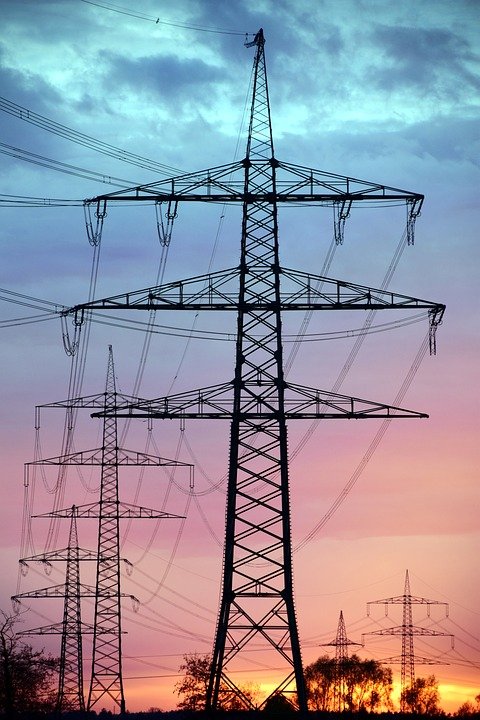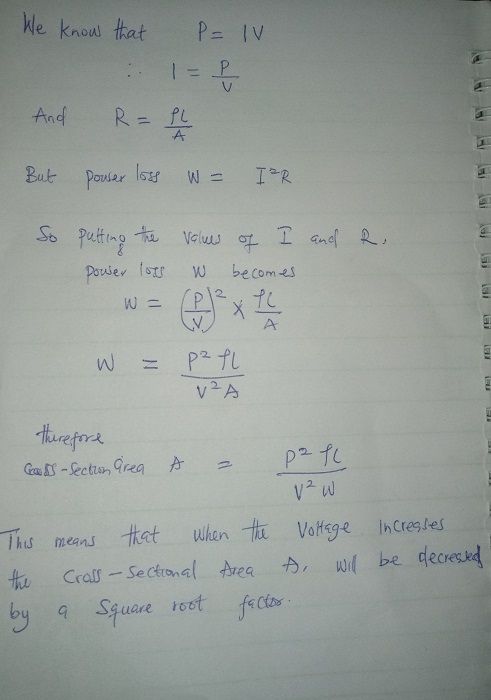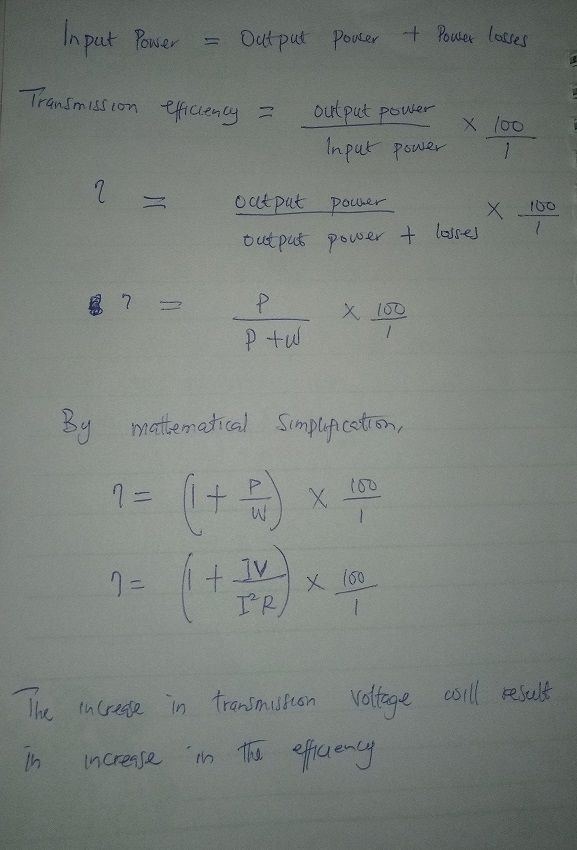I remember my first year studying electrical engineering and I got to know that bulk electrical power is transmitted as High voltage Low current, since the product of current and voltage gives power (P = IV) so whether it is high current-low voltage or high voltage-low current or same quantity of current and voltage, as long as their product gives the desirable power, all is fine. It sounded like a good argument but, practically power is transmitted at high voltage-low current. Why is like that and not the other way around?

High voltage transmission lines. from maxpixel under the cco license
ELECTRICITY BASICS
First we need to understand some basics about electricity and electric power transmission. Like I said earlier, power can consist of voltage and current, and it could also be a relationship between current and resistance, so that the power will be a product of the square of the current and the resistance to the flow of current (P = I2R). Current is the flow of electric charge, Voltage is the potential energy per unit charge, or simply put is the force that pushes current to flow in a circuit, Resistance is the opposition to the flow of electric current. Something interesting is that when current is made to flow through a conductor or cable, with a finite resistance, there will be loss along the conductor which will be both voltage drop (product of current and resistance, V = IR) and power loss (product of the square of current and resistance, P = I2R). The magnitude of the resistance a cable can offer to current flow will depend on:
- the resistivity of the material the cable is made of (copper or aluminum);
- the length of the conductor;
- the diameter (cross-sectional area).
There exist a relationship between these properties that affect the resistance of a conductor. The product of the resistivity ρ, and length l, is divided by the cross-sectional area (ρl/A). This means that if the resistivity of the cable increases, the resistance will increase correspondingly, also if the length of the cable increases, the resistance of the cable will also increase, but the same will not be said of the cross-sectional area because if it increases (if we make the cable bigger) the resistance of the cable will reduce, and this is simply because more current will pass through without opposition. This relationship will be very important throughout the article.
Now, after understanding these basics we can move on to understand why we have to transmit power at high voltage.
Why High Voltage
To reduce the volume and weight of the conductor
When electric energy is generated at the generating station, which is usually a lot of distance from where it is needed, and as such long length of cables will be required to transmit the electric power. So in order to reduce the volume of the entire cable, the cross-sectional area has to be reduced. How can this be achieved? By increasing the voltage to a sufficiently high value. The relationships described earlier will be used to demonstrate how it is possible. This will reduce the cost of transmission lines.Reduction in line losses
Resistance increases as the length of the cable increases, as it has been established. For transmission lines, the length of the cable required is a lot of kilometers, which means the resistance of the cable too will be very high. If power is transmitted over that long distance with increased value of current, possibility is that the power will all be lost to heat due to very high resistance and as such may not get to its destination.
We know that (R= ρl/A) so since the length required is very much, the resistance of the cable will increase greatly. Also we know that power loss, W = I2R so if we transmit at high current over a long distance, the loss will very great. But a sufficient decrease in the current present in the transmission will reduce the losses on the line. To maintain the same electric power required for the transmission, the voltage has to be raised corresponding to the decrease in the current. Hence, high voltage therefore decreases the loss on the line.
Increase in Transmission Efficiency
Transmission efficiency is measured as a percentage of input power that reaches the output. A transmission line is said to be efficient, if its efficiency is high enough. Realistically, its efficiency cannot be 100%, as this will mean there is no loss along the line, which is practically impossible. Input power = output power + power losses This means that, the higher the losses, the lower the output power (power at the receiving end). Transmission efficiency = (power output / power input) X 100% The mathematical analysis shows that high voltage transmission helps to increase the transmission efficiency.Improved Voltage Regulation
If power is transmitted at high voltage, current will be low and this means that there will be lesser voltage drops along the line, and the voltage regulation will be increased. But then what is voltage regulation? Voltage Regulation is defined here as, the drop in receiving end voltage from no load to full load expressed as percentage of Receiving end voltage.
It is expressed in percentage as ( Vs-Vr)/Vr X 100
Where
At no load, the receiving end voltage is the same as the sending end voltage since there is no loss along the line.
At full load the receiving end voltage is less than the sending end voltage.
The difference in full load and no load voltage with respect to the receiving end voltage is the voltage regulation. This means that when the percentage regulation is low, it is better for the transmission line, and this is only possible if the voltage drops along the line is low. The voltage drop can only be low if the transmission current is low as well.
The high voltage transmission obviously has proven to be the realistic method for bulk electric power transmission. It however has its own inherent limitations, but do not out-weigh the advantages. It is important to also consider this limitation so as to learn.
Limitations of High Voltage Transmission
- Insulation Requirement
Tower Height
Due to the high voltage across the line, there is a standard distance the conductors must maintain from the ground to ensure safety of humans and animals. This mean that the transmission towers must be sufficiently high to achieve that. High towers mean more cost.Corona loss and Radio Interference
If you do not understand the concept of corona, just check through my previous post. Very high voltages causes corona losses and can generate signals whose frequencies can cause radio interference or Electromagnetic interference.Transformer Requirement
Bigger transformers will be required to step up to a high voltage at the generating station and also to step the voltage down at the receiving stations. Cost of incurring and maintaining these transformers is another disadvantage.
.jpg)
High voltage transformer from wikimedia commons
Regardless of the limitations, it is only realistic to transmit bulk electric power over a long distance at High voltage.
CONCLUSION
As a student, this part of electrical engineering was interesting to learn, and am always eager to teach others when the need arise! I do hope that you have learnt something new or reminded yourself of past memories. Drop your comments and let us relate.
References Used
- High voltage Transmission Advantages and disadvantages
- Advantages of very high voltages for transmission Purpose
- Voltage Regulation and Efficiency of Transmission Line
- Limitations of EHV Transmission
If you write STEM (Science, Technology, Engineering, and Mathematics) related posts, consider joining #steemSTEM on steemit chat or discord here. If you are from Nigeria, you may want to include the #stemng tag in your post. You can visit this blog by @stemng for more details.




Well done sir.
I will like to ask, if we transmit at high current, would there be need for large insulation?
In terms of human safety which one is better, high voltage or high current?
Also, if high current is used do we need large height as well?
Downvoting a post can decrease pending rewards and make it less visible. Common reasons:
Submit
Good questions.
yes there would be need for a lot of insulation at high current except that we won't need so much spaces in between the insulators. Because air is an insulator, we won't require as much spaces between them as we have in high voltage.
like a saying that it is current that kills not the voltage. Which happens to be correct to 90deg. So if the operating current is high, and we experience a fault on the line and it happens to fall to the ground, casualties might increase drastically. We will also put operators life at danger incase of a switch because of the amount of current present in the breakers.
tower height might not be that much.
But in all, safety has to be considered first above all, and the high voltage offers more of that. The advantages of high current doesn't outweigh the disadvantages.
Thanks a lot for stopping by
Downvoting a post can decrease pending rewards and make it less visible. Common reasons:
Submit
Thanks for the response.
Downvoting a post can decrease pending rewards and make it less visible. Common reasons:
Submit
Wow , ,very goods your post,
Downvoting a post can decrease pending rewards and make it less visible. Common reasons:
Submit
Wow!!! This is just an amazing post. Making your solving in the brings a lot of originality into the post, your other images are properly sourced. You have given quite a lot of knowledge on power transmission systems. Really nice post @real2josh, keep up the good work.
Downvoting a post can decrease pending rewards and make it less visible. Common reasons:
Submit
Thanks. I appreciate your time.
Downvoting a post can decrease pending rewards and make it less visible. Common reasons:
Submit
A good reminder up there. Having tread the path of Civil engineering for so lomg, ideas like this are bound to elope ones brain (or at least would seem to).
Thanks for the little tutorial.
Downvoting a post can decrease pending rewards and make it less visible. Common reasons:
Submit
Yeah. Hope u enjoyed it
Downvoting a post can decrease pending rewards and make it less visible. Common reasons:
Submit
Good to see u explaining Voltage vs Current characteristics in simplified form..!
As I'm also from the EEE backgroud, I would like to suggest u to be a little more careful about ur equations. If not formatted correctly, equations can spread misleading information.
Ur looks more like
looks more like  .
.
Voltage regulation equation is also kind of misleading.
U can use Latex or html commands to properly format equations..!
If u need further assistance, feel free to ask at our Discord, a group of experienced and helpful mentors are willing to help whenever u need..!
Best regards..!🙌
Downvoting a post can decrease pending rewards and make it less visible. Common reasons:
Submit
@christinaa thanks, I'll give it a trial. If I need help, ill contact you
Downvoting a post can decrease pending rewards and make it less visible. Common reasons:
Submit
Sure..!
Best wishes to u..!
Downvoting a post can decrease pending rewards and make it less visible. Common reasons:
Submit
You nailed it, I always love simplicity especially on topics that seem complicated. I remember the first time someone tried to explain something about this to me, before then I used to wonder why step it and then buy another transformer to step it down. Thanks for sharing your knowledge.
Downvoting a post can decrease pending rewards and make it less visible. Common reasons:
Submit
Now i understand why we have high voltage and low current. These are one of the things my lecturer was trying to explain then was quite difficult to grab then.
But you made this simple. The heavier the conductor the more the losses and the more problems we have with transmission lines.
Downvoting a post can decrease pending rewards and make it less visible. Common reasons:
Submit
Being A SteemStem Member
Downvoting a post can decrease pending rewards and make it less visible. Common reasons:
Submit